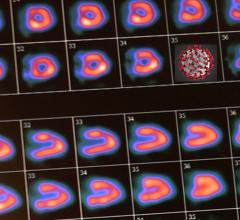
As the U.S. government works to strengthen its global nuclear security strategy by eliminating potential sources of bomb-grade highly enriched uranium (HEU), it has eyed the production of medical isotopes for nuclear imaging, which rely on HEU. To encourage reliable supplies of medical radioisotopes produced from non-HEU sources, President Obama signed into law on Jan. 2, 2013, the American Medical Isotopes Production Act of 2011 (AMIPA). It should be noted that it was part of the 2013 National Defense Authorization Act, so the measure goes beyond interest in just making sure patients have access to radiopharamceutical tracers to enable myocardial perfusion imaging (MPI) scans. The effort is designed to make HEU sources less available on the world market to reduce the threat of nuclear weapons proliferation or the building of a “dirty bomb.”
The AMIPA encourages the domestic production of LEU molybdenum-99 (Mo-99 — the parent isotope to produce the imaging radiotracer technetium-99m) and provides for the eventual prohibition of the export of HEU from the United States. In addition, the Centers for Medicare and Medicaid Services (CMS) recently stipulated in the 2013 final Medicare payment rules, for Medicare hospital outpatients, that CMS will provide incremental reimbursement for every Tc-99m exam dose produced from non-HEU sourced Mo-99. Lantheus’ LEU TechneLite generator satisfies the new reimbursement requirements under the CMS 2013 rules.
As a result, Lantheus Medical Imaging added a low-enriched uranium (LEU) TechneLite technetium-99m (Tc-99m) generator to its nuclear imaging product portfolio. The LEU TechneLite generator is the first Tc-99m generator in the United States that contains Mo-99 produced from at least 95 percent LEU. With greater access to LEU Mo-99 through its supply chain diversification strategy, Lantheus said it has moved closer to its goal of eventually eliminating HEU-sourced Mo-99 from its supply chain. Lantheus’ first LEU TechneLite generator was shipped on Jan. 7, 2013.
Mo-99 decays to Tc-99m, which is used in more than 16.7 million nuclear imaging procedures in the United States each year.
“We are pleased to be the first company to offer a Tc-99m generator produced using at least 95 percent LEU,” said Don Kiepert, president and chief executive officer of Lantheus Medical Imaging. “As leaders in nuclear medicine, an important component of our global sourcing strategy is to increase our use of LEU-sourced Mo-99 with a goal of 100 percent by 2016. Our TechneLite generator is used in many critical diagnostic imaging procedures, including scans of the heart, brain, bone, kidneys and some types of tumors. The introduction of our LEU TechneLite generator expands our nuclear medicine product portfolio and meets CMS’ new reimbursement requirements for Medicare hospital outpatients in 2013, while supporting the government’s non-proliferation goal.”
In 2012, Lantheus announced expanded access to LEU-sourced Mo-99 with an extended agreement with NTP Radioisotopes in South Africa. Under the five-year agreement, Lantheus will receive an increasing supply of Mo-99 produced from LEU targets from NTP Radioisotopes (NTP) and Australian Nuclear Science and Technology Organization (ANSTO). Additionally, Lantheus announced continued supply of Mo-99 from Nordion, used in the production of the company’s non-LEU TechneLite generators.


 August 03, 2023
August 03, 2023 








